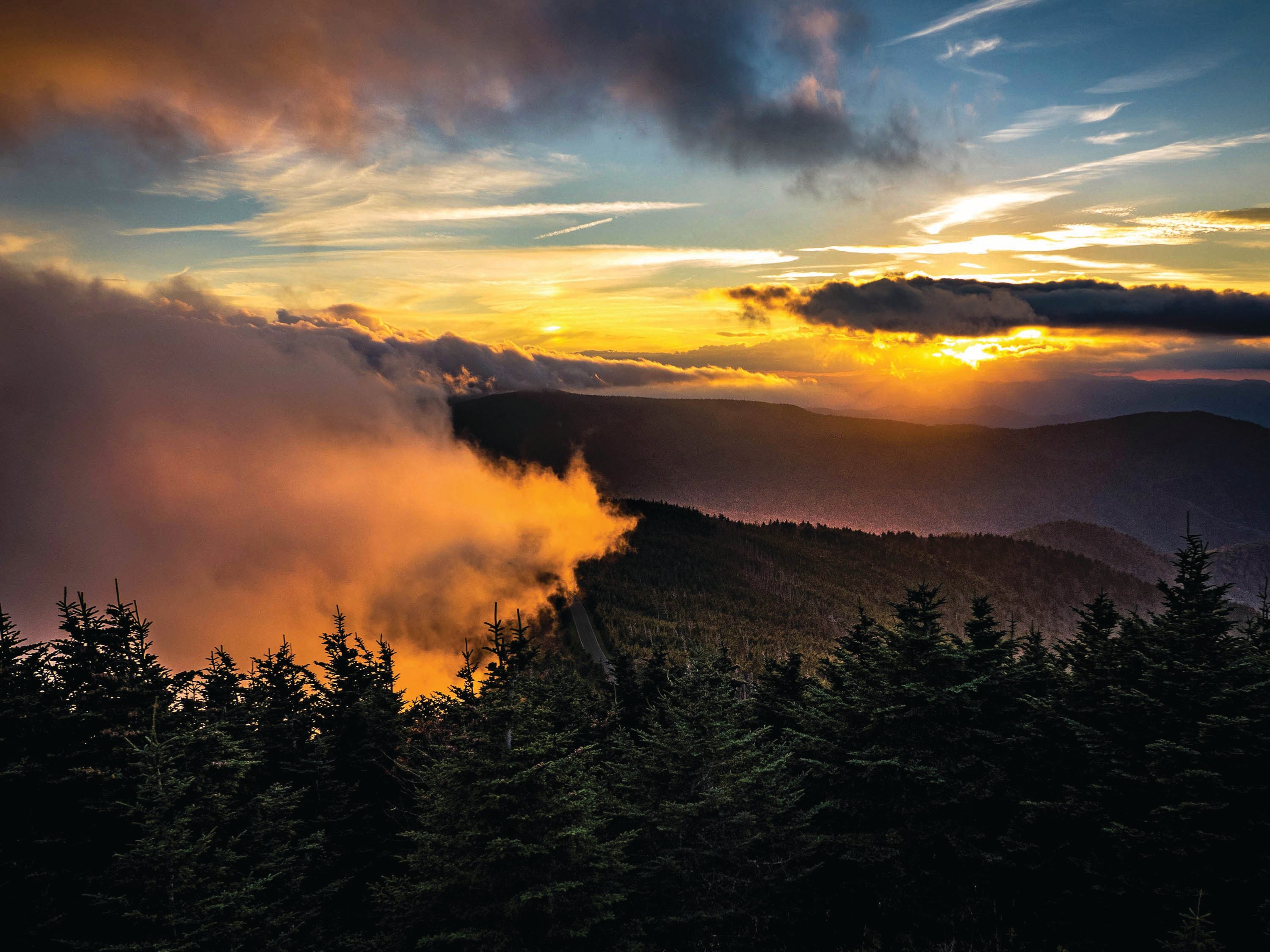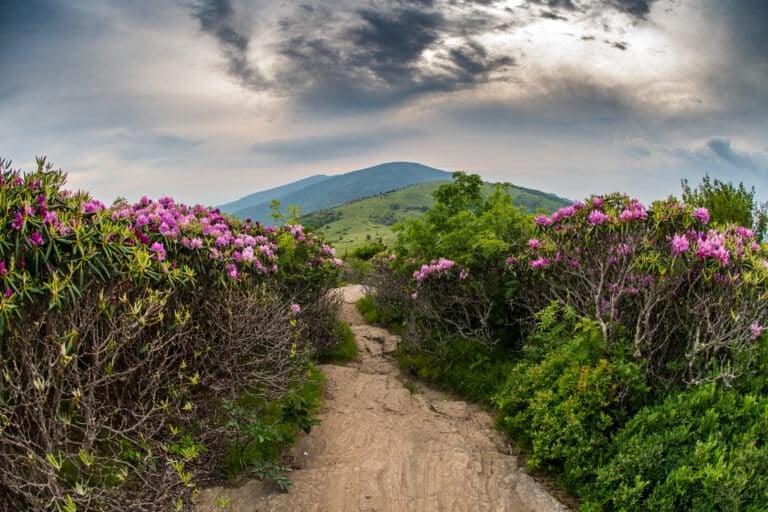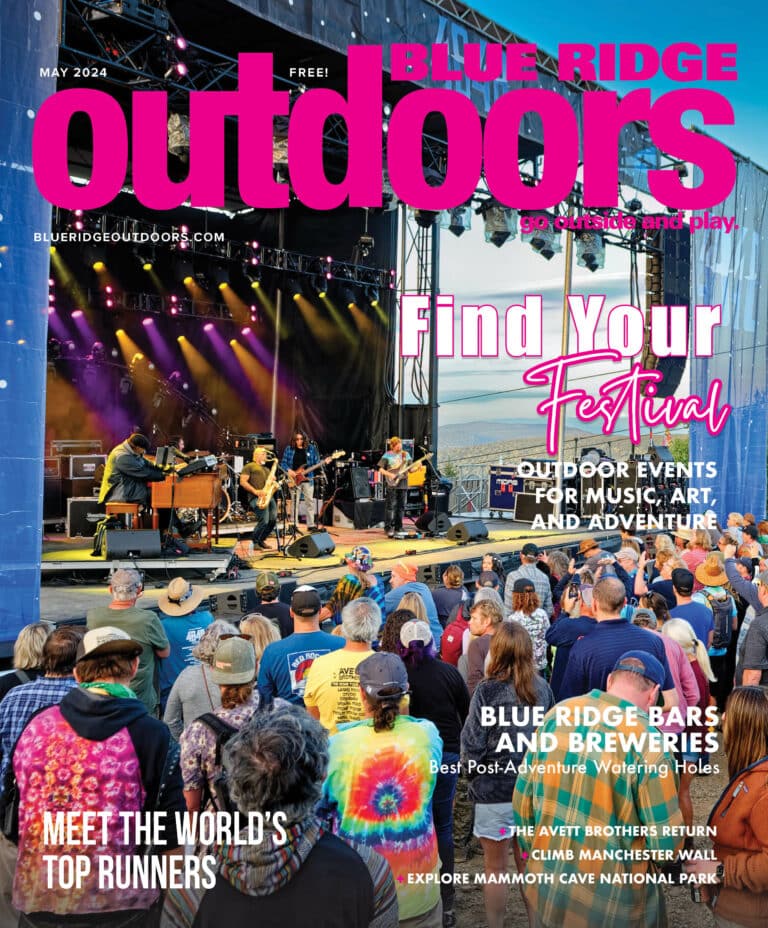The rain was relentless, the overgrown briers showed no mercy on their legs, it was dark when they started and when they finished. And after 16 hours on the trail they were met with a bear prowling around the shelter. The bear came sniffing around again, even after being tranquilized by a park ranger.
“That first day was the scariest,” says Anne Riddle.
Understatement? It was day one of six in the summer of 2009, when long-distance runners Anne Riddle, Rebekah Trittipoe and Jenny Anderson (collectively known as The Cats) took off to set the women’s record for scaling all 40 of the Southern Appalachian’s 6,000-foot peaks in one continuous effort, a challenge known as the South Beyond 6,000 (SB6K).
According to Vance Mann, a volunteer administrator of the Carolina Mountain Club, which sponsors the program, the guidelines of the SB6K don’t include a time limit. In fact, he says most participating hikers take anywhere from six months to two years to complete the challenge, and there’s no trophy for knocking it out any faster than the next guy. There is, however, a certificate and a patch, which Mann, a 75-year-old hiking enthusiast who’s been involved with the club for a decade, mails to anyone who completes the SB6K.
But you know those ultra-runners—why walk a trail when they could run it?
Team Effort
Their first day began around 2am in the Clingmans Dome parking lot and ended about 50 miles, eight peaks, and 16 hours later. Between the water-logged shoes, the blisters, the unwelcome campsite guest, the nonstop rain, and the overwhelming fatigue, there were certainly moments when Riddle considered quitting.
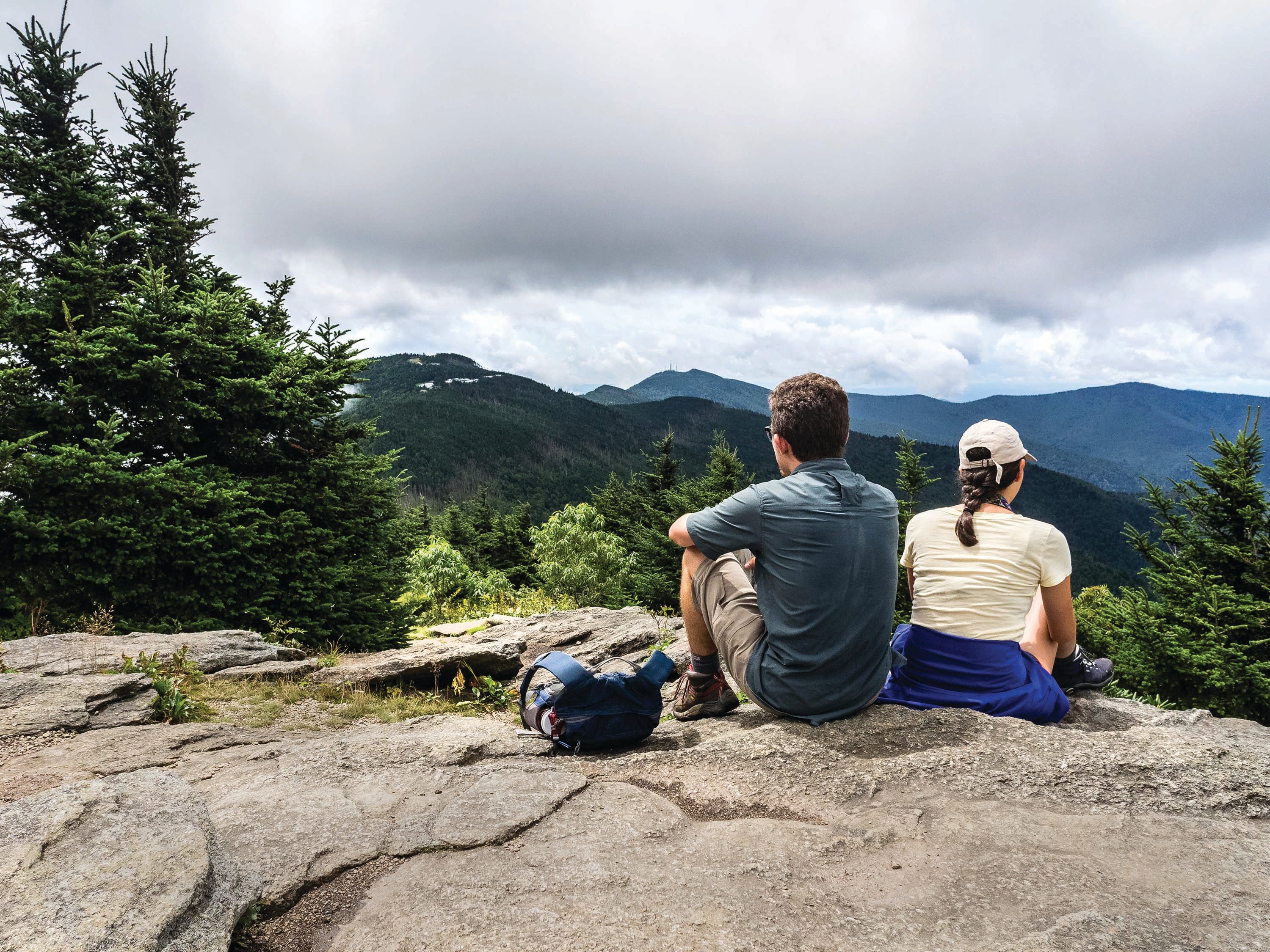
“There are times when you’re just like, oh my god, this sucks, why did I sign up to do this,” she says. “But there were times when it was really fun. Time’s just flying, you feel like you’ve got tons of energy and it’s just a beautiful day.”
Riddle joined her high school cross-country team as a freshman, after concluding that contact sports requiring hand-eye coordination weren’t her forte. (She still identifies as a clumsy athlete, citing the seemingly endless bumps and bruises she acquired during those six days.) She continued logging miles during and after college, but it wasn’t until her 30s, when she owned a running shop, that she considered tip-toeing into the ultra world. A woman entered the store looking for a watch that counted up to 100 miles. Bewildered, Riddle asked why, and the woman’s answer was simple: she ran 100 miles at a time.
“I was looking at her, this elementary school teacher, and she seemed like a normal person,” Riddle recalls, noting that she and the customer had similar body types. “I thought, OK, well if she can do it, maybe I can do it.”
The more ultra-runners Riddle surrounded herself with, the more respect she developed for the sport. It’s a slippery slope, though, from that first 50K race to a six-day challenge covering 300 miles.
“Before I had ever met any ultra-runners I thought these people must be crazy, they must be like Olympians, another species,” she says. “But I started meeting people who do more and more crazy long, hard things, and I realized they’re just normal people who happen to set a goal and work really hard to do it.”
Riddle’s list of running accolades is a long and impressive one, but the SB6K was a different beast. For starters, the choice to run with two other women was deliberate. A starting line, a designated course, and a couple hundred fellow runners don’t come with the SB6K like a traditional race, and Riddle preferred the idea of tackling the challenge with a like-minded cohort, for both safety and camaraderie.
The trio agreed to stick together and only be as fast as the slowest person, and even when someone pulled ahead or fell behind, Riddle says they were generally within about 100 meters of each other. And every time they reached a peak, The Cats paused as a group to (briefly) enjoy it together.
“Doing an adventure like that really kind of tests your relationship skills and ability to compromise and negotiate and that sort of thing,” she says. “When you’re by yourself you can go at your own pace and you don’t have all those personalities to take into account, but it is nice having people there to encourage you. At moments when I was feeling low, maybe someone else was feeling really good, and vice-versa along the way.”
This was Riddle’s first multi-day, overnight running excursion, and essential to the group’s success was their crew. A small band of supporters followed along in a vehicle, meeting them at shelters and in parking lots with sleeping bags, hot food and dry clothes. Friends also popped in on occasion to run a couple (or a couple dozen) miles with them, and Riddle fondly recalls the day some pals hand-delivered giant Starbucks frappuccinos. And one morning, fellow runners greeted them with coffee, chocolate-chip pancakes, and breakfast burritos, a meal that Riddle describes as “the most heavenly.”
A couple years later, Riddle paid it forward by meeting Matt Kirk out on the trail during his own SB6K journey, equipped with breakfast burritos.
Going Solo
For Matt Kirk, the SB6K was a pipe dream for years. Kirk was a young, mountain-loving college kid who had just discovered trail running when he received an email from speed demon Ted “Cave Dog” Keizer in 2002. Kirk immediately recognized Keizer as the guy who had set a record on Colorado’s 14,000-footers (also known as 14ers) in 2000, and Keizer had come across a rudimentary web page that Kirk had set up to document his own experience on North Carolina’s sixers.
“He thought I was an expert on these mountains,” Kirk laughs. “Of course I wasn’t, but I guess you can fake anything on the internet these days.”
He may not have considered himself an expert 15 years ago, but that would be a tough argument to make now. He talked with Keizer about the sixers, and the seed was planted.
“It became a little project,” Kirk says. “He wanted to just pick them off, not in any speedy fashion, but to collect experiences.”
Famous last words. Keizer, whose goal was to string all 40 peaks (15 of which have no designated trails) together in one continuous footpath, slapped the final summit marker after four days, 23 hours, and 28 minutes. Seven years later, Kirk shattered that record, knocking out all 40 peaks in four days, 14 hours and 38 minutes.
Because so many of the mountains are quite literally off the beaten path and the 40 peaks aren’t conveniently arranged in a straight line, it’s difficult to pinpoint specific mileage for the SB6K. Kirk picked the brains of everyone who came before him and spent many a weekend with his wife, exploring on and off the trails, tracking GPS points and bushwhacking his way through rhododendron and briers to the top of the less obviously accessible mountains.
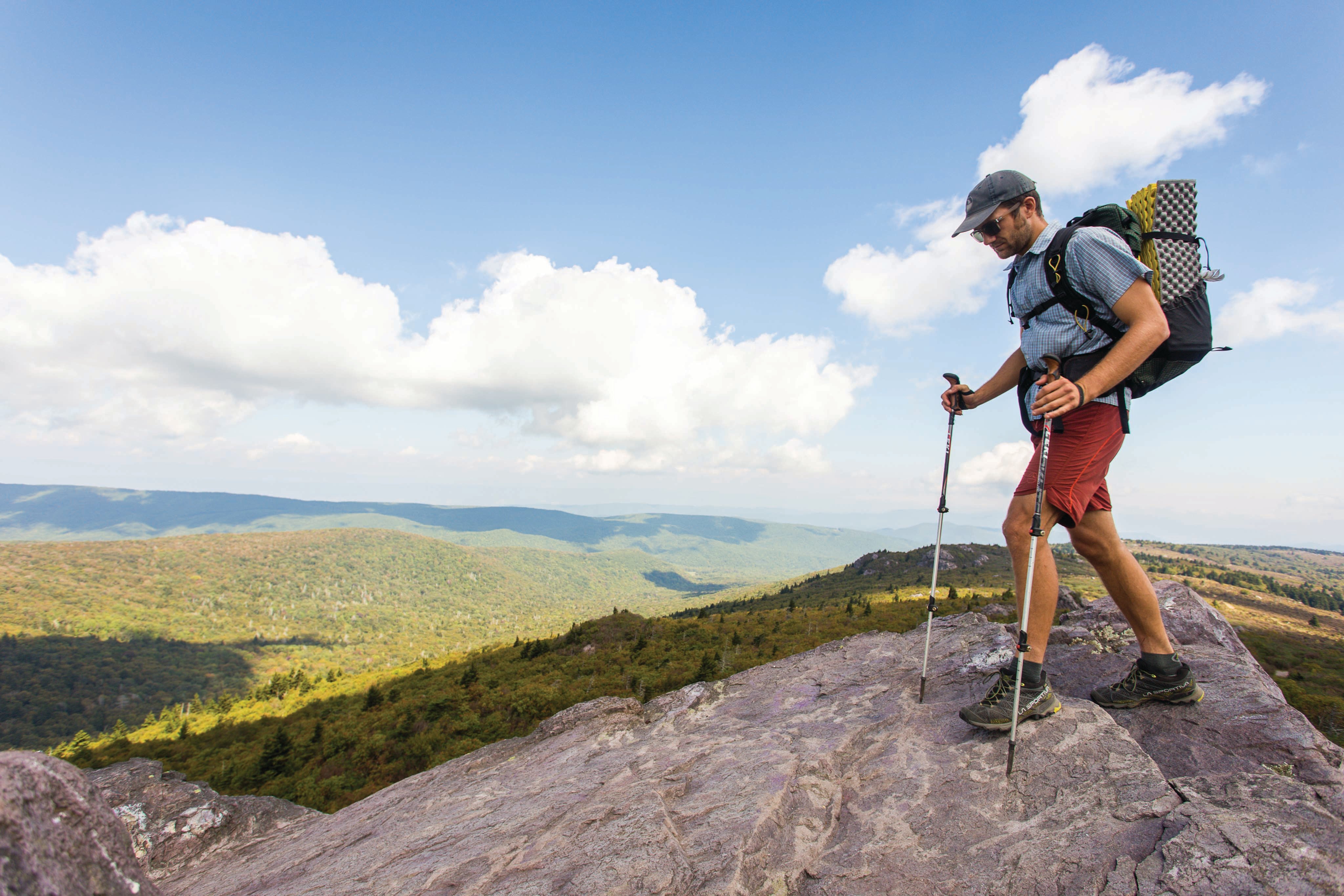
Between the weekend excursions (which Kirk says were just as much fun as the timed trial, if not more so) and combing through the trail notes that Keizer and The Cats had graciously shared with him, Kirk plotted out a time-efficient route that shaved what he estimated to be about 50 miles off the originals.
Kirk ran solo for most of the four-and-a-half days, but he’s the first to point out that he didn’t do it alone.
“The thing that made this stand out as a success really had less to do with my athletic ability and all to do with the great support and phenomenal weather we had,” he says.
Kirk’s dad met him at the end of each long day in a Volkswagen bus circa 1970s loaded down with gear and a kitchen for morning omelets, plus Kirk’s wife and friends made appearances along the way. With the exception of some misty, uncomfortable conditions during his connection from Mt. Mitchell to Celo Knob, Kirk says he couldn’t have asked for better weather.
“It was nice and chilly in the mornings, enough to get you going, really clear with low humidity, just incredible views,” he says. “The morale from being out in that kind of environment day in and day out just really kept spirits pretty high.”
He didn’t exactly allow himself to take it all in, though. Upon scaling a peak he was more likely to inhale a protein bar, retie his shoes, take a deep breath, and head back down than he was to sit back and enjoy the panoramic views.
“Which I don’t recommend to people,” he says. “It’s not the best way to do it, but I knew I was following in the footsteps of someone I had a lot of respect for and their time was not going to be easy to beat.”
The Southern Summits
“When I did the challenge, I had lived and trained in Western North Carolina for 16 years,” Riddle says. “But through this process I experiencedtrails I had never before visited.” They may be record-holders, but Riddle and Kirk are more than happy to share their secrets so fellow trail runners and hikers can follow in their footsteps. If you’re thinking about exploring the 40 peaks (in a continuous race with the clock or otherwise), this may be a good place to start.
BLACK MOUNTAINS
“The Black Mountains are fun, as you can knock out seven of them in seven miles, mostly along the Black Mountain Crest Trail,” Riddle says. “It’s steep and techincal, but with amazing views.”
MITCHELL—6,684 FT. YANCEY COUNTY, N.C.
As the tallest point east of the Mississippi and the inspiration for one of the country’s first state parks, Mt. Mitchell is a popular destination for North Carolinians and travelers alike. it’s easily accessible from a vehicle so it can “feel pretty touristy,” Riddle says, but that just gives the experience even more variety, especially in comparison to the remote peaks.
CRAIG 6,647 FT. (N.C.)
BALSAM CONE 6,600 FT. (N.C.)
CATTAIL PEAK 6,600 FT. (N.C.)
GIBBES 6,520 FT. (N.C.)
HALLBACK 6,329 FT. (N.C.)
CELO KNOB 6,327 FT. (N.C.)
BLACKSTOCK KNOB 6,320 FT. (N.C.)
WINTER STAR MOUNTAIN 6,203 FT. (N.C.)
GIBBS MOUNTAIN 6,200 FT. (N.C.)
GREAT SMOKY MOUNTAINS
GUYOT 6,621 FT. (TENN.)
LE CONTE 6,593 FT.
According to Kirk, you have to “really want to get to that peak,” because there’s no nearby trailhead. Kirk describes Mt. Le Conte as a “broad, gentle giant.” Reaching the top requires some bushwhacking, but it’s worth the effort.“It’s like an enchanted forest and a completely different biome up there,” he says. “It’s really high up and you’re walking on all these spruce needles. It’s just a really cool setting up there, kind of tucked away.”
CHAPMAN 6,417 FT. (TENN.)
CLINGMANS DOME 6,643 FT. (N.C.)
COLLINS 6,188 FT. (N.C.)
OLD BLACK 6,370 FT. (N.C.)
LUFTEE KNOB 6,234 FT. (N.C.)
KEPHART 6,217 FT. (TENN.)
MARKS KNOB 6,169 FT. (N.C.)
BIG CATALOOCHEE MOUNTAIN 6,155 FT. (N.C.)
TRICORNER KNOB 6,120 FT.
“The peaks that stand out to me as the most challenging were in the Tricorner shelter area,” Riddle says. “The shelter is 15 miles from vehicular access, so it’s necessary to hike in all of one’s supplies.” As much as she and the group wanted to call it a day when they arrived at the shelter in the afternoon, they pressed on and added Mt. Sequoyah, Mt. Chapman, and Marks Knob to the day’s list.
SEQUOYAH 6,003 FT. (TENN.)
GREAT BALSAM MOUNTAINS
“I’m partial to some of the peaks along the Art Loeb trail, which is where I had my first ultra adventure in North Carolina,” Kirk says. “That trail goes over Black Balsam, Tennent, Shining Rock, all the way to Cold Mountain.”
RICHLAND BALSAM 6,410 FT. (N.C.)
BLACK BALSAM KNOB 6,214 FT.
One of Riddle’s “favorite mountains anywhere,” Black Balsam Knob is near milepost 420 on the Blue Ridge Parkway. The bald, grassy views of the Great Balsam Mountains remind her of being out West.
HARDY 6,120 FT. (N.C.)
REINHART KNOB 6,080 FT.
Off the parkway across from the more touristy Richland Balsam Knob, “Reinhart Knob, is a bit of a forgotten mountain,” Kirk says. It may not particularly stand out, but he describes it as one of the steepest, most difficult climbs.
SAM KNOB 6,040 FT. (N.C.)
GRASSY COVE TOP 6,040 FT. (N.C.)
TENNENT MOUNTAIN 6,040 FT. (N.C.)
COLD MOUNTAIN 6,030 FT. (N.C.)
SHINING ROCK 6,000 FT.
Affectionately known to hikers as the crown jewel of Appalachia, Shining Rock is one of Riddle’s favorites for its breathtaking snowy white quartz formations at the top.
CHESTNUT BALD 6,000 FT. (N.C.)
PLOTT BALSAMS
WATERROCK KNOB 6,292 FT. (N.C.)
LYN LOWRY 6,240 FT. (N.C.)
PLOTT BALSAM MOUNTAIN 6,088 FT. (N.C.)
YELLOW FACE 6,032 FT. (N.C.)
ROAN-UNAKA MOUNTAINS
ROAN HIGH KNOB 6,285 FT. (N.C.)
ROAN HIGH BLUFF 6,267 FT. (N.C.)
GRASSY RIDGE BALD 6,160 FT. (N.C.)
GREAT CRAGGY MOUNTAINS
CRAGGY DOME 6,080 FT. (N.C.)
